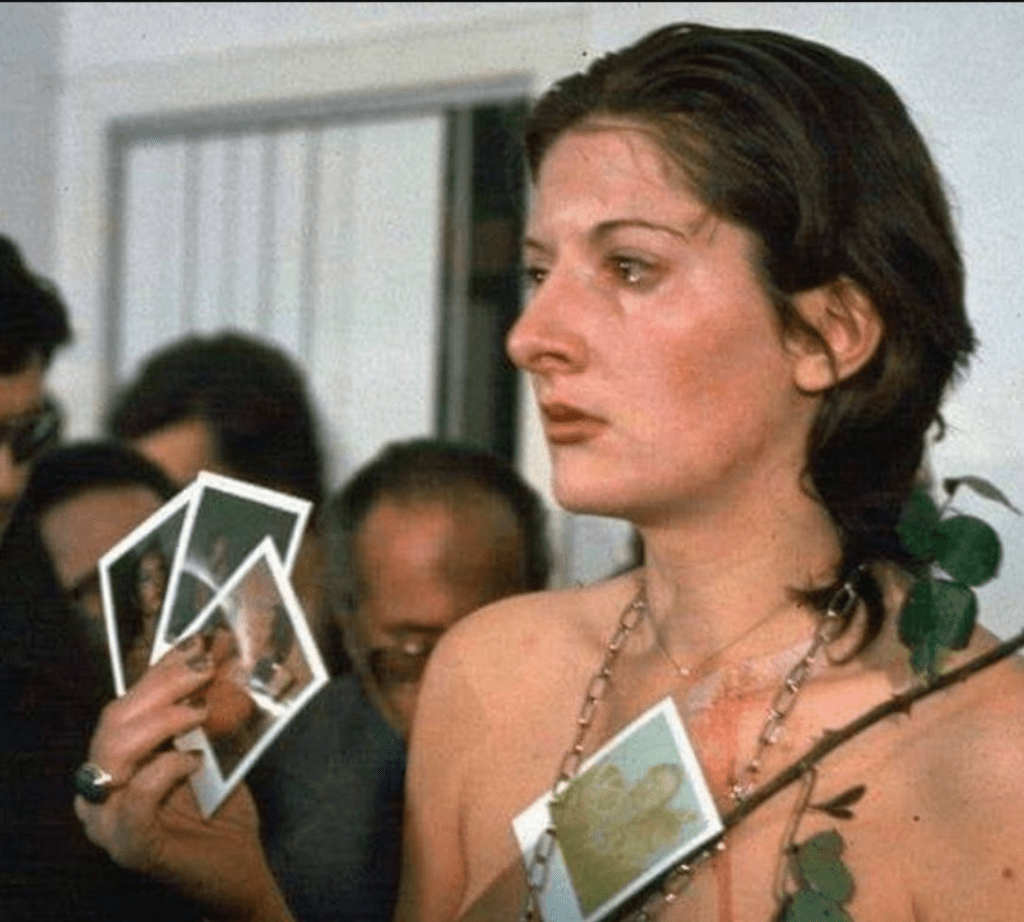Marina Abramović, a renowned performance artist, has once again captured the public’s attention with her provocative 1974 piece, Rhythm 0. In this performance, Abramović surrendered herself completely to the audience, allowing them to do anything they wanted to her for six hours. The results were both chilling and revealing. So, why would an artist subject herself to such a dangerous and vulnerable experience? Abramović has shared her motivation, shedding light on the artistic and societal implications of her work.
What Was Rhythm 0? The Controversial Art Performance That Shocked the World

Rhythm 0 took place in a gallery in Naples, Italy, over 40 years ago, yet it still resonates today. For this piece, Abramović placed herself in a room with a table holding 72 objects, each one symbolizing either pleasure or pain. The objects ranged from benign items like a rose and a feather to more threatening ones, including a knife and a loaded gun. Abramović’s only instruction to the audience was chillingly simple: “I am an object. You can do whatever you want with me, and I will take full responsibility for six hours.”
Initially, the performance seemed innocent, with people gently interacting with her, using flowers or light touches. But as the hours passed, the audience’s behavior shifted dramatically, revealing the darker side of human nature. People began cutting her clothes, inflicting minor injuries, and ultimately, one person even held the gun to her head. The piece highlighted how people’s actions can devolve when accountability fades away.
Why Did Abramović Create This Piece? Exploring the Artist’s Intentions
The question that haunts many who hear about Rhythm 0 is, why? What motivated Abramović to put herself in such a vulnerable position? According to the artist, Rhythm 0 was a response to the criticism artists faced in the 1970s for pushing boundaries and challenging societal norms. Abramović wanted to create a piece that removed her agency entirely, allowing the audience to exercise their free will, for better or worse.
In an interview with The Museum of Modern Art (MoMA), Abramović explained, “I wanted to see how far the public would go. In the beginning, they played gently, but eventually, they became aggressive. I wanted to reveal the complexities of human behavior when left unaccountable.”
This experiment was more than just an exploration of her own limits; it was a statement about society and how people react under certain conditions. It posed a powerful question: When given the power to do anything without consequences, what will people choose to do?
The Dark Transformation: From Curiosity to Cruelty
In Rhythm 0, the audience’s behavior escalated from playful to violent over the course of the performance. While some people in the crowd attempted to shield Abramović from harm, others took advantage of her vulnerability. Items like the rose and feather were quickly abandoned in favor of the knife and gun. Abramović has recounted some of the disturbing actions that took place, including participants who cut her clothes, pressed a gun to her temple, and even drank her blood.
In her own words, Abramović described these hours as “real horror,” explaining that the shift in behavior happened gradually but with intensity. She noted, “The public went from passive observers to active participants in an increasingly violent spectacle. They placed the knife between my legs and cut my skin, leaving me half-naked and exposed.”

This transformation within the crowd demonstrated the dangers of mob mentality and how easily people can become desensitized to violence when they see others participating. Rhythm 0 forced the audience, and later the world, to confront a harsh reality about human nature.
A Statement on Accountability: Why Rhythm 0 Still Matters Today
Abramović’s Rhythm 0 was not only a performance but also a powerful social experiment. By relinquishing control, she forced her audience to confront their own capacity for cruelty. Her passive role as “the object” removed any moral or ethical barriers the audience might have felt, allowing them to act out their impulses without fear of retribution.
The piece illustrates a timeless message about accountability. It challenges us to consider how we might act if we believed no one was watching or if we knew there would be no consequences for our actions. In many ways, Rhythm 0 serves as a warning about the potential for violence and dehumanization in situations where accountability is removed.
@conversationswithevan The Dangers and Daring of Marina Abramovic’s Performance Art “Rhythm 0” #performanceart #marinaabramovic #rhythm0 #art #storytime #avantegarde #learn #interesting #fyp ♬ original sound – Conversations with Evan
This message is especially relevant today, in a world where social media often enables anonymity, allowing people to say or do things they might never consider in a face-to-face setting. Abramović’s work forces us to look in the mirror and ask ourselves whether we would have the integrity to act responsibly when the world’s eyes are not upon us.
The Psychological Impact on Abramović: “Ready to Die” for Her Art
Reflecting on the experience, Abramović has shared how she mentally prepared herself for the worst, acknowledging that she was “ready to die” for this piece. In a 2010 interview with The Guardian, she recalled some of the darkest moments, including the time a man pressed the gun to her head and another just stood there, breathing heavily as if savoring the control he held over her.
Her willingness to face death demonstrates a level of commitment that is rare in any profession, let alone in the art world. Abramović wanted to make a statement so powerful that she risked her life to complete it. This level of dedication speaks volumes about her belief in the transformative power of art and its ability to provoke thought, dialogue, and ultimately change.
Legacy of Rhythm 0: A Lasting Impact on Art and Society

Today, Rhythm 0 continues to spark discussions about human behavior, the boundaries of art, and the psychological effects of unchecked power. Abramović’s work has become a case study in both art schools and psychology classes, a testament to its profound impact.
Through this performance, Abramović captured the duality of human nature—the capacity for kindness and cruelty that exists within all of us. Her willingness to endure six hours of uncertainty and pain has made Rhythm 0 one of the most iconic pieces of performance art in history.
As she reflected years later, Abramović highlighted how Rhythm 0 revealed not only the potential for brutality but also the strength of art to serve as a mirror to society. “Just because you can, doesn’t mean you should,” she stated, summarizing a lesson that transcends time and place.
Conclusion: A Powerful Reminder of the Depth of Human Nature
In the end, Marina Abramović’s Rhythm 0 offers a haunting reminder of the power of choice and the responsibility that comes with it. By making herself vulnerable to the whims of strangers, she illuminated both the beauty and darkness within humanity. Her performance transcends mere shock value, standing as a profound exploration of freedom, control, and moral accountability. Rhythm 0 remains a vital piece that challenges us to reflect on our own actions and consider the impact of a world where consequences are absent.
For anyone inspired by her courage, Abramović’s work serves as a reminder that art can sometimes hold up a mirror to our deepest, most hidden selves. And sometimes, we may not like what we see.


